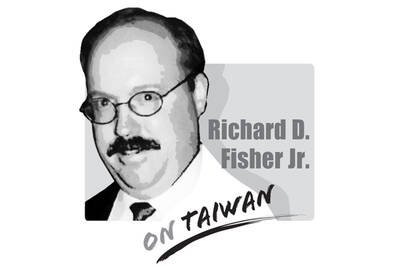Those who argue that President Ma Ying-jeou’s (馬英九) cross-strait policies are bearing fruit would have rejoiced at news earlier this month that, for the first time in decades, the People’s Liberation Army (PLA) held a major drill that did not include a Taiwan scenario.
On Aug. 12, the South China Morning Post reported a drill codenamed Kuayue (“Stride”) 2009 had been launched, mobilizing 50,000 heavily armed troops from four military zones — Shenyang, Lanzhou, Jinan and Guangzhou — over thousands of kilometers. Ni Lexiong (倪樂雄), a Shanghai-based military specialist, said the unprecedented maneuver reflected the new circumstances in the Taiwan Strait.
“You can see that the Nanjing Military Command, the military region on the cross-strait front line, which played a key role in many military drills in history, isn’t taking part this time,” Ni said. “It’s because cross-strait ties have become warmer since Ma Ying-jeou was elected Taiwan’s president last year.”
While this development could be interpreted as a “goodwill” gesture from Beijing, or as reciprocity in light of the fact that Taiwan, under Ma, has also transformed the posture of its military drills, it also reflects more imminent threats to Chinese stability by “separatist” forces in Xinjiang and Tibet. Indeed, Ni was quoted as saying that the Lanzhou Military Command, which oversees security in the Tibet and Xinjiang regions, would become “more important.”
Another factor that cannot be ignored is that Beijing is trying to win the “hearts and minds” of Taiwanese and to facilitate the Ma administration’s efforts to normalize cross-strait relations. As such, not holding a drill simulating an invasion of Taiwan sends the right signals and buttresses the perception that Ma is succeeding in easing tensions in the Strait.
However, history is not without periods when Beijing played down military exercises. In the early 1990s, when the Straits Exchange Foundation and China’s Association for Relations Across the Taiwan Strait met for the first time, Beijing’s saber-rattling became less strident — until former president Lee Teng-hui’s (李登輝) visit to Cornell University and the 1996 elections, when the PLA held massive military exercises and fired missiles that landed near Keelung and Kaohsiung. Initially, Beijing had seen Lee as “their man,” a leader they could work with to facilitate unification. When it realized that this was not the case, Beijing flexed its muscles anew.
Something similar occurred in the first months of former president Chen Shui-bian’s (陳水扁) administration. Fearful of Chen’s pro-independence views, China — at the time seeking entry into the WTO — acted with caution and opted not to use the military card. Soon afterwards, however, Beijing reintroduced exercises and continued to modernize its armed forces with a Taiwan scenario as its main objective.
All this suggests that Kuayue 2009 is not a departure from the PLA’s record, nor does it signify that a new era is at hand in the Taiwan Strait. After all, despite a massive reshuffle among military academies, frontline units and military commands ahead of the PLA’s 82nd anniversary on Aug. 1, the Chinese military — under President Hu Jintao (胡錦濤), who doubles as chairman of the Central Military Commission — remains very much its own creature. As such, a shift at great variance from the PLA’s posture over the past 60 years is highly unlikely.
Kuayue 2009 focused on Tibet and Xinjiang, but this does not reflect cross-strait reciprocity.
Instead, the switch was pragmatic, reactive and consistent with the present phase of dealing softly with the Taiwan issue. But the game could change in a heartbeat.
We are used to hearing that whenever something happens, it means Taiwan is about to fall to China. Chinese President Xi Jinping (習近平) cannot change the color of his socks without China experts claiming it means an invasion is imminent. So, it is no surprise that what happened in Venezuela over the weekend triggered the knee-jerk reaction of saying that Taiwan is next. That is not an opinion on whether US President Donald Trump was right to remove Venezuelan President Nicolas Maduro the way he did or if it is good for Venezuela and the world. There are other, more qualified
China’s recent aggressive military posture around Taiwan simply reflects the truth that China is a millennium behind, as Kobe City Councilor Norihiro Uehata has commented. While democratic countries work for peace, prosperity and progress, authoritarian countries such as Russia and China only care about territorial expansion, superpower status and world dominance, while their people suffer. Two millennia ago, the ancient Chinese philosopher Mencius (孟子) would have advised Chinese President Xi Jinping (習近平) that “people are the most important, state is lesser, and the ruler is the least important.” In fact, the reverse order is causing the great depression in China right now,

This should be the year in which the democracies, especially those in East Asia, lose their fear of the Chinese Communist Party’s (CCP) “one China principle” plus its nuclear “Cognitive Warfare” coercion strategies, all designed to achieve hegemony without fighting. For 2025, stoking regional and global fear was a major goal for the CCP and its People’s Liberation Army (PLA), following on Mao Zedong’s (毛澤東) Little Red Book admonition, “We must be ruthless to our enemies; we must overpower and annihilate them.” But on Dec. 17, 2025, the Trump Administration demonstrated direct defiance of CCP terror with its record US$11.1 billion arms
As technological change sweeps across the world, the focus of education has undergone an inevitable shift toward artificial intelligence (AI) and digital learning. However, the HundrED Global Collection 2026 report has a message that Taiwanese society and education policymakers would do well to reflect on. In the age of AI, the scarcest resource in education is not advanced computing power, but people; and the most urgent global educational crisis is not technological backwardness, but teacher well-being and retention. Covering 52 countries, the report from HundrED, a Finnish nonprofit that reviews and compiles innovative solutions in education from around the world, highlights a